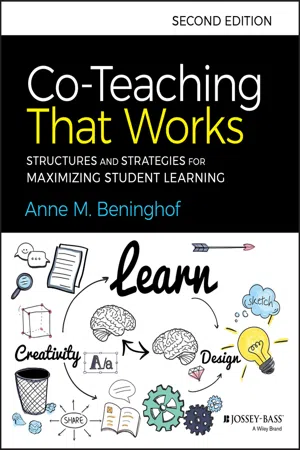
Co-Teaching That Works
Structures and Strategies for Maximizing Student Learning
- English
- ePUB (mobile friendly)
- Available on iOS & Android
About this book
Guaranteed Success for the Co-teaching Classroom
Following the success of the first edition, Co-Teaching That Works: Structures and Strategies for Maximizing Student Learning, Second Edition is here to provide actionable advice to co-teachers seeking to utilize one another's strengths. Unlike other co-teaching books, this manual is written for every possible educator combination—not simply general educators. You'll find sections on everything from co-teaching in literacy and speech-language therapy to special education and technology so that, no matter what subject matter or expertise, you'll be prepared to co-teach.
This book is written to provide concrete, actionable advice, including:
- Co-Teaching Roll Out Plans
- Leadership Guidelines
- Relationship Development
- Best Co-Teaching Models
- Specially Designed Instruction
- And more
Educators will have the opportunity to learn from other experienced co-teachers who share their personal stories, tips, and tried-and-true co-teaching techniques that lead to student success. Their creative, time-efficientapproaches will revolutionize the way you view your classroom teaching strategies and enhance your ability to collaborate with other educators.
Whether you are planning to build your co-teaching strategy from scratch or just looking to refine your current approach, Co-Teaching That Works will undoubtedly be a priceless resource to have in your professional toolbox.
Frequently asked questions
- Essential is ideal for learners and professionals who enjoy exploring a wide range of subjects. Access the Essential Library with 800,000+ trusted titles and best-sellers across business, personal growth, and the humanities. Includes unlimited reading time and Standard Read Aloud voice.
- Complete: Perfect for advanced learners and researchers needing full, unrestricted access. Unlock 1.4M+ books across hundreds of subjects, including academic and specialized titles. The Complete Plan also includes advanced features like Premium Read Aloud and Research Assistant.
Please note we cannot support devices running on iOS 13 and Android 7 or earlier. Learn more about using the app.
Information
PART ONE
DEVELOPING A RECIPE FOR SUCCESS
CHAPTER 1
An Overview of Co-Teaching
What Is Co-Teaching?
What Does the Research Say?
- An elementary school study showed that students with disabilities made significantly more progress in co-taught classes than those in separate educational settings, with the difference growing over time (Tremblay 2013).
- A study on teacher competency showed that co-teaching resulted in improved content knowledge for special educators and improved pedagogical knowledge for general educators. Researchers concluded that co-teaching resulted in co-constructed professional development for participants which benefited students in inclusive settings (Shaffer and Thomas-Brown 2015).
- A research review concluded that when co-teachers work closely together and have the time to plan, small positive outcomes are achieved (Solis, Vaughn, Swanson, and McCulley 2012, 507). These same researchers found, comparing co-teaching to other forms of consultation, that “when specialists recommend improved instructional practices to teachers, instructional changes are unlikely to be realized in the classroom. However, when the specialists coordinate c...
Table of contents
- COVER
- TABLE OF CONTENTS
- THE AUTHOR
- Introduction
- PART ONE: DEVELOPING A RECIPE FOR SUCCESS
- PART TWO: SERVING UP EFFECTIVE INSTRUCTION
- PART THREE: MAXIMIZING UNIQUE TALENTS
- PART FOUR: THE FINISHING TOUCHES
- APPENDIX: Instructional Strategies for Co-Taught Classrooms
- REFERENCES
- INDEX
- END USER LICENSE AGREEMENT